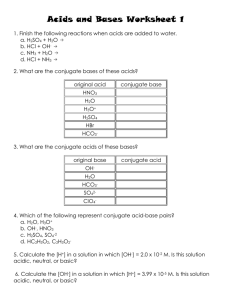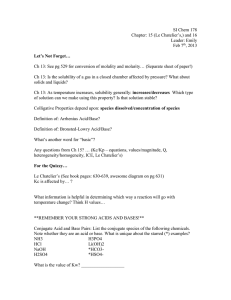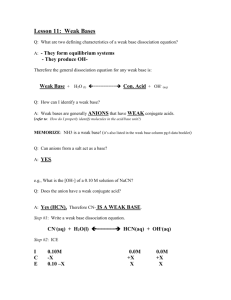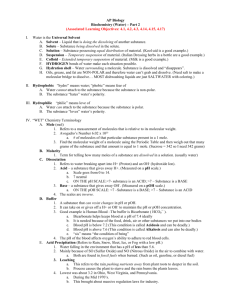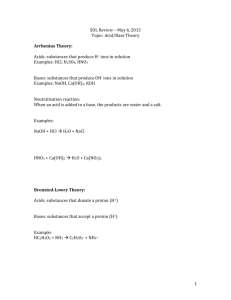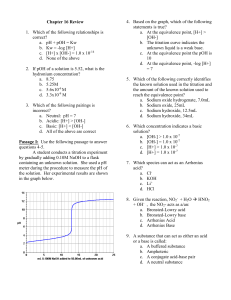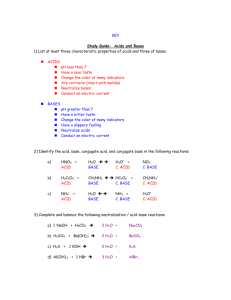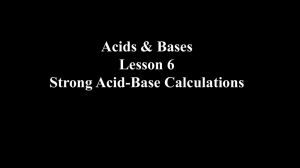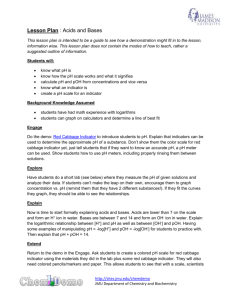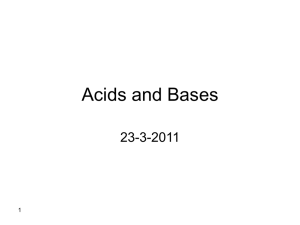Acid Base Chemistry Problem Set: pH, Brønsted-Lowry
advertisement
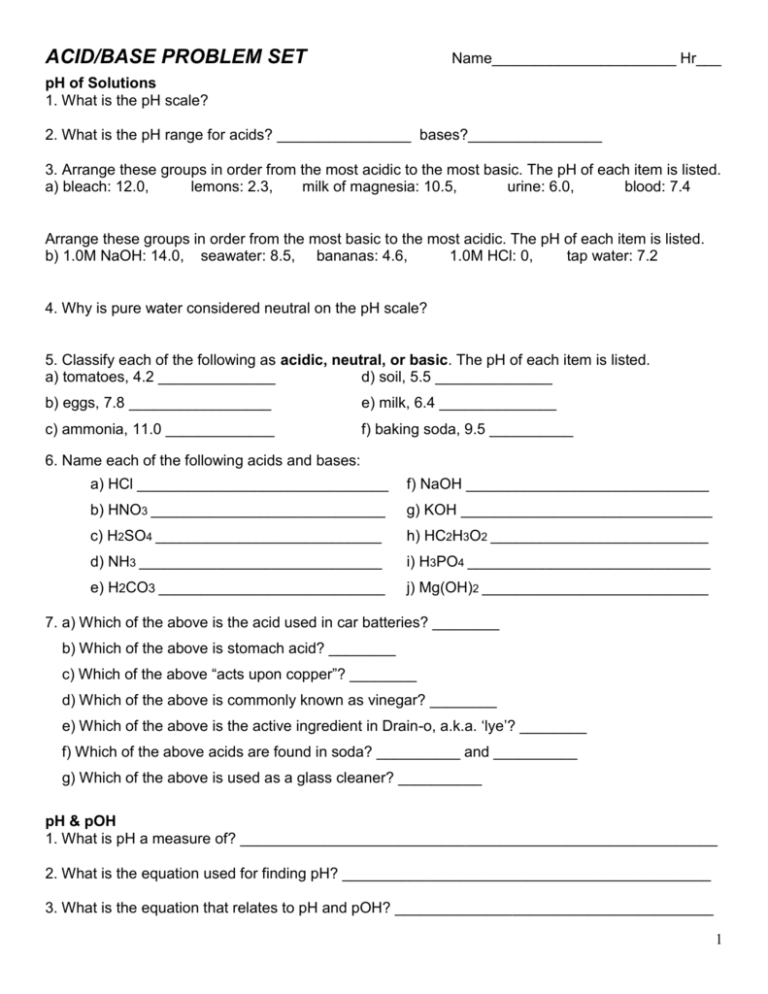
ACID/BASE PROBLEM SET Name______________________ Hr___ pH of Solutions 1. What is the pH scale? 2. What is the pH range for acids? ________________ bases?________________ 3. Arrange these groups in order from the most acidic to the most basic. The pH of each item is listed. a) bleach: 12.0, lemons: 2.3, milk of magnesia: 10.5, urine: 6.0, blood: 7.4 Arrange these groups in order from the most basic to the most acidic. The pH of each item is listed. b) 1.0M NaOH: 14.0, seawater: 8.5, bananas: 4.6, 1.0M HCl: 0, tap water: 7.2 4. Why is pure water considered neutral on the pH scale? 5. Classify each of the following as acidic, neutral, or basic. The pH of each item is listed. a) tomatoes, 4.2 ______________ d) soil, 5.5 ______________ b) eggs, 7.8 _________________ e) milk, 6.4 ______________ c) ammonia, 11.0 _____________ f) baking soda, 9.5 __________ 6. Name each of the following acids and bases: a) HCl ______________________________ f) NaOH _____________________________ b) HNO3 ____________________________ g) KOH ______________________________ c) H2SO4 ___________________________ h) HC2H3O2 __________________________ d) NH3 _____________________________ i) H3PO4 _____________________________ e) H2CO3 ___________________________ j) Mg(OH)2 ___________________________ 7. a) Which of the above is the acid used in car batteries? ________ b) Which of the above is stomach acid? ________ c) Which of the above “acts upon copper”? ________ d) Which of the above is commonly known as vinegar? ________ e) Which of the above is the active ingredient in Drain-o, a.k.a. ‘lye’? ________ f) Which of the above acids are found in soda? __________ and __________ g) Which of the above is used as a glass cleaner? __________ pH & pOH 1. What is pH a measure of? _________________________________________________________ 2. What is the equation used for finding pH? ____________________________________________ 3. What is the equation that relates to pH and pOH? ______________________________________ 1 4. Are the following solutions acidic, neutral, or basic? a) [H+] = 1 x 10-8 M _________________ d) [H+] = 0.1 M ____________________ b) [OH-] = 1 x 10-10 M ________________ e) [H+] = 1 x 10-5 M _________________ c) [OH-] = 1 x 10-6 M ________________ f) [OH-] = 0.00001 M ________________ g) Complete the following table: [H+] [OH-] pH pOH acidic, basic, or neutral 1.0 x 10-3 M 1.0 x 10-11 M 3 11 Acidic 1.0 x 10-5 6.37 0.045 0.00000096 4.31 7.00 5. What is the pH of each of the following? a) 0.0010 M HCl _____________ g) 0.024 M HCl _____________ b) 0.0010 M HNO3 ____________ h) 0.075 M KOH ____________ c) 0.010 M NaOH _____________ i) 0.000034 M HCl ___________ d) 0.0035 M HCl _____________ j) 0.0001M HCl _____________ 6) What is the pH and pOH of a 1.20 x 10-3 M HBr solution? 7) What is the pH and pOH of a 2.34 x 10-5 M NaOH solution? 8) What is the pH and pOH of 120.0mL of a solution containing 0.00500grams of hydrochloric acid? 9) What is the pH and pOH of 660.0L of a solution containing 0.00740moles of nitric acid? 2 10) What is the pH and pOH of a solution made by adding water to 15.0 grams of hydroiodic acid (HI) until the volume of the solution is 2500.0 mL? 11) What is the pH and pOH of a solution that was made by adding 400.0 mL of water to 350.0 mL of 5.00 x 10-3 M NaOH solution? 12) What is the pH and pOH of a solution with a volume of 5.04 L that contains 15.0 grams of hydrochloric acid and 25.0 grams of nitric acid? Brønsted-Lowry Acids and Bases 1. What is the Brønsted definition of an acid? _________________________ 2. What is the Brønsted definition of a base? __________________________ 3. What is the correct name for the H3O+ ion? _________________________ 4. Determine the conjugate base for the following acids: HF: _______ HNO2 -1: _______ NH4+1: _______ H2O: _______ H3PO4: _______ 5. Determine the conjugate acid for the following bases: OH-1: _______ Br -1: ________ NH3: ________ H2O: ________ CO3 -2: ________ 6. Identify the conjugate acid/base pairs in the following reactions: a) HCN + H2O <---> H3O+1 + CN-1 acid:_________ base: _________ conjugate base: ___________ conjugate acid: __________ b) H2O + HSO4-1 <---> SO4-2 + H3O+1 acid: _________ base: _________ conjugate base: __________ conjugate acid: __________ 7. Write the equation for the hydrolysis of HNO2 (a weak acid) in water, labeling each acid/base pair: 8. Write the equation for the hydrolysis of NH3 (a weak base) in water, labeling each acid/base pair: 3 9. Some acids have a unique property: the ability to donate more than one proton (H+) per molecule. A molecule that can donate 1 proton is called a monoprotic acid. Example = ___________ A molecule that donates 2 protons is a ____protic acid. Example = ___________ A molecule that donates 3 protons is called a _____protic acid. Example = ___________ Ionization 1. Describe what occurs when water ionizes (“self-ionization of water”). Include an equation and an explanation. 2. What are the molar concentrations of [H+] and [OH-] in pure water at 25°C? 3. What is the ion-product constant, Kw? _________________ 4. Find [H+] for solutions having the following [OH-] value: a) [OH-] = 1 x 10-13 b) [OH-] = 2.7 x 10- 4 c) [OH-] = 1 x 10- 3 d) [OH-] = 6.3 x 10-10 5. Calculate [OH-] of a solution when its [H+] has the following values: a) [H+] = 1 x 10-13 b) [H+] = 3.6 x 10- 5 c) [H+] = 1 x 10- 2 d) [H+] = 7.8 x 10- 8 6. A solution contains 0.635 g NaOH in 236 mL solution. a) Write the equation for the dissociation of NaOH: b) What is the [OH-]? c) What is the [H+]? 7. A solution contains 0.737 g HNO3 in 934 mL solution. a) Write the equation for the dissociation of HNO3: b) What is the [H+]? c) What is the [OH-]? 4
